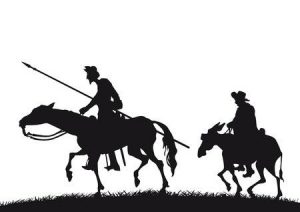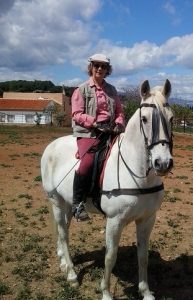Making long journeys on horseback
A number of people have asked me now about how far a horse can go in a day. The simple answer is: ‘that depends’.
It depends on the age and skill of the rider, the age, type and fitness of the horse, and the terrain they have to cover.
 Healthy, well-trained horses entered in modern long-distance races, sometimes called endurance races (for a very good reason) can cover up to 100 miles in a day. The favoured breed is the Arabian, but while the type of breed matters, it’s the training that is important. Each mount has to be prepared for these distances over a long period of time, and this includes getting used to eating hard fodder at different times of the day, which many horses do not or will not do.
Healthy, well-trained horses entered in modern long-distance races, sometimes called endurance races (for a very good reason) can cover up to 100 miles in a day. The favoured breed is the Arabian, but while the type of breed matters, it’s the training that is important. Each mount has to be prepared for these distances over a long period of time, and this includes getting used to eating hard fodder at different times of the day, which many horses do not or will not do.
In the wild, equines graze for most of the day and night; kept in stables they become accustomed to eating and drinking water at certain times of the day. Breaking that routine with stabled horses can lead to colic. Horses that are being prepared for long distances need not only to have excellent physical stamina and good leg bones, they need to learn to feed and drink on a completely different basis.
Basically, this means if you have characters in a book covering long distances you need to take into account that horses are not machines. They also lose shoes and go lame, which can slow a journey if not bring it to a halt altogether. Here are three sample questions on this topic with my answers:
Q: My characters hire livery horses to cross open territory to get to a remote village, taking about four days on the journey. One character is an excellent horseman but the rest have limited experience. They take their food, equipment and weapons. What do I also need to mention or include?
Your characters will need to hire sound, sturdy horses at the livery stable – cross breeds probably. Do not include any mention of English Thoroughbreds, they are not well-suited to rough terrain. Each horse will need its own properly fitting saddle and bridle, plus a head collar with a rope line and/or hobbles. Ill-fitting saddles can cause a lot of damage: the wrong size bit can destroy the animal’s mouth and make it unresponsive or downright difficult. Your group should also hire at least one pack mule for their equipment, and they may need to take fodder for their horses as well, unless they are crossing lush terrain. Think about water, too: horses can survive a day without food, but not without water. Remember that one person will have to have the mule’s leading rein, so it doesn’t try to run back home.
If your group are travelling for four days and there is no great haste, one mount per person, plus a pack mule should be all right, but a spare mount would be useful in case one of the horses loses a shoe or steps in a rabbit hole, which happens surprisingly easily. Horses stumble and ‘twist their ankles’ much the same as we do. They have numerous small bones in the foot and hock and can go lame for a while. The hock area may swell up, but then the beast may recover after a rest.
What sort of horses do you need for a long journey? Does gender matter? Gender doesn’t matter as long as no stallion is present. A stallion is easily distracted by a mare; if she’s in season he can become uncontrollable. Some, (but not all) stallions also challenge or try to attack geldings, this can include biting and striking out with front legs. Geldings are generally more reliable, but mares and geldings can be equally difficult depending on age and temperament. I have an aging gelding with an appalling imagination: he’s quite capable of seeing mortal danger in the flight of a bird or a falling leaf if the mood takes him, or if it’s a windy day. High winds confuse horses’ olfactory and auditory signals. Mares can often get awkward when they come into season.
I’ve read that horses don’t need as much sleep as we do and that a mini herd takes turns sleeping throughout the night. Could my characters sleep through the night knowing that horse is on guard against predators and will alert them?
Horses, being prey animals are always on guard. They can sleep standing up using a bone-locking device so, if necessary, they can make a quick getaway. This means they are often dozing on the hoof and from a distance it looks as if they are awake. Most horses only lie down to sleep if they feel very safe in their surroundings. They might be unsettled in strange terrain and more restless if there are predators around. I’m not sure about individuals taking turns to be on guard in a herd, but I think your human characters need to take shifts to stay alert during the night in open country.
A common way to hobble horses in the past, and still used in rural areas of Spain, is to tie the front legs together at the hock so they can move sufficiently while grazing but not trot or gallop, so they can’t get very far. Tying horses to trees or lines as they do in the movies is unreliable because they can break their tethers if they choose to. A horse tied to a tree can break its reins, bridle or head collar very easily – I’ve seen it done more than once. Smarter horses can rub their heads against the tree to get out of bridles and head collars, too. I had a mare who could get herself out of just about anything except her saddle.
Remember that while horses are usually gentle and willing, they do have immense strength when need be. You also need to take into account that restless horses can be very hard to tack up and they make each other nervous.
As to distances, here is a general guide to equine miles per hour, but please remember, horses are sprinters; keeping up fast pace for a long period can tax or even destroy the healthiest animal. The rest depends on the age and condition of the horse, its load and the rider.
Walk: 4 mph
Trot: 8 to 12 mph
Canter: 12 to 15 mph
Gallop: 25 to 30 mph
 A final word: these blog posts are written from my personal experience of a life-time caring for and training horses. If you go to other on-line sources you may find conflicting or differing information.
A final word: these blog posts are written from my personal experience of a life-time caring for and training horses. If you go to other on-line sources you may find conflicting or differing information.
JGH
Málaga, 5th November, 2018

